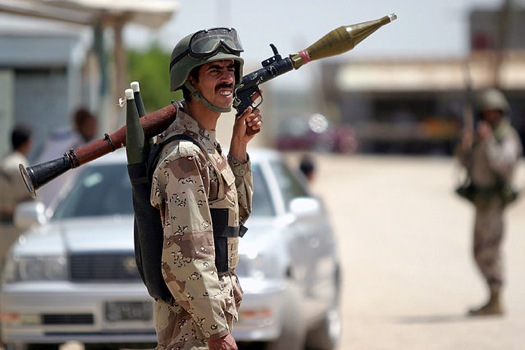
Iraqi Security Force member armed with RPG-7, 2005. Via Wikimedia Commons.
It is one of the most successful designs on the planet, a rugged, adaptable device that has been in service for 50 years and outperforms far more expensive models.
It is the product of continuous refinement, simplification and customer feedback. It rebuts the myth that military developers never turn out anything but expensive over-engineered design — or that communist countries never produced designs that worked.
Unfortunately, what it does is spread murder and mayhem.
The rocket-propelled grenade, or RPG, is used by armies and insurgents all over the world. Created in the Soviet Union, the RPG-7 has been employed in Yemen and Uganda, Chechnya and Vietnam. Most recently, it has shown up in the hands of Libyan rebels, its metal warhead silhouetted against the sky like a missile or minaret. According to a senior military official speaking to NPR correspondent Tom Gjelten, the weapons are coveted by Libyan rebels “‘because with those they could stop Gadhafi's tanks.’"
Ironically, after attempting to duck them for decades, the U.S. has begun making its own RPG-7s — built by the firm Airtronic — and may distribute them to rebel movements. Despite its grim function, the RPG-7 stands as one of the supreme examples of design for global success, built on ideals of simplicity, functionalism, durability and ease of use and maintenance.
"RPG-7s are in the militaries of over 40 countries,” notes Col. Leslie Grau, a recognized expert on the weapon. “They are simple and cheap and everywhere. They don't take much training."
Such ease is a function of the RPG-7’s rudimentary design, says Richard Jones, editor of the military journal Jane's Infantry Weapons. “There are no electronics to break, no mechanism to jam."
And yet this $10 weapon can destroy a $50 million helicopter or $5 million tank, making the RPG the mascot of asymmetrical warfare. The launcher weighs just 16 pounds, but the warhead can penetrate 4 feet of reinforced concrete, 6 feet of bricks and 2 feet of metal.
A crude mix of wood and metal, with a blast end trumpet resembling a diabolical musical instrument, the RPG is terrifying: No one forgets the sight and sound of it — the whoosh, the blue-gray smoke and the slightly wobbly rotation of the projectile’s flight. Fear lies on both sides: The RPG’s shooter has to have the courage to get within 200 or 300 meters of the target, according to Russian journalist Artyom Borovik in The Hidden War, his classic account of the Soviet war in Afghanistan.
RPGs brought down the helicopter in Black Hawk Down. “Basically, the RPG singlehandedly lost the Russians their first Chechen War,” writes Gary Brecher, author of a newspaper column on military strategy. Half of all U.S. deaths in the first months of the current Iraq War were caused by RPGs, according to a study by the Center for Army Lessons Learned. Osama Bin Laden posed with RPGs, and John Kerry is seen holding a captured Viet Cong RPG in his war snapshots. In 2000 the Real Irish Republican Army launched RPGs at the headquarters of MI6, the British Secret Intelligence Service. War rugs woven by refugees in Pakistan and Iran show RPGs in their patterns, along with helicopters and jets.
Today’s models are descendents of the U.S. bazooka and of Hitler’s Panzerfaust, which was used in the last days of World War II. Beginning in the 1940s, the Russians improved the Panzerfaust by stages. The weapon took its present form in 1961. The initials composing its name translate to both English (Rocket-Propelled Grenade) and Russian (Raketniy Protivotankoviy Granatomet — literally, “rocket anti-tank grenade launcher”). The Soviet Union licensed the weapon for manufacture in factories in such hot spots as China, Libya and Iran, and at the state arsenal of Iraq. By the end of the Cold War, the world was full of cheap RPGs, and their utility was well established.
The RPG-7 carries cultural and social overtones, like another sturdy Russian weapon: the AK-47, whose biography is the subject of C. J. Chivers’s recent book, The Gun. It figures in photos and films as an icon of rebellion. Just as one man’s insurgent is another’s freedom fighter, the RPG can be seen as either the sling of David against totalitarian Goliaths or the terrorist’s Saturday night special. The RPG threatened the Stryker vehicles that were the centerpiece of former Defense Secretary Donald Rumsfeld’s new military strategy. "The RPG-7 will be around for a good while yet," says Col. Grau. "It is a proven, cheap killer of technology which will continue to play a significant role — particularly when conventional forces are pitted against irregular forces.”
The Pentagon seems to agree in ordering up a somewhat easier-to-use version for its arsenal that is made in the USA.
What if someone invented a device that did good as efficiently as the RPG does harm? Imagine a benign twin of the RPG that gave life and healed wounds? That would be a design worth celebrating.
